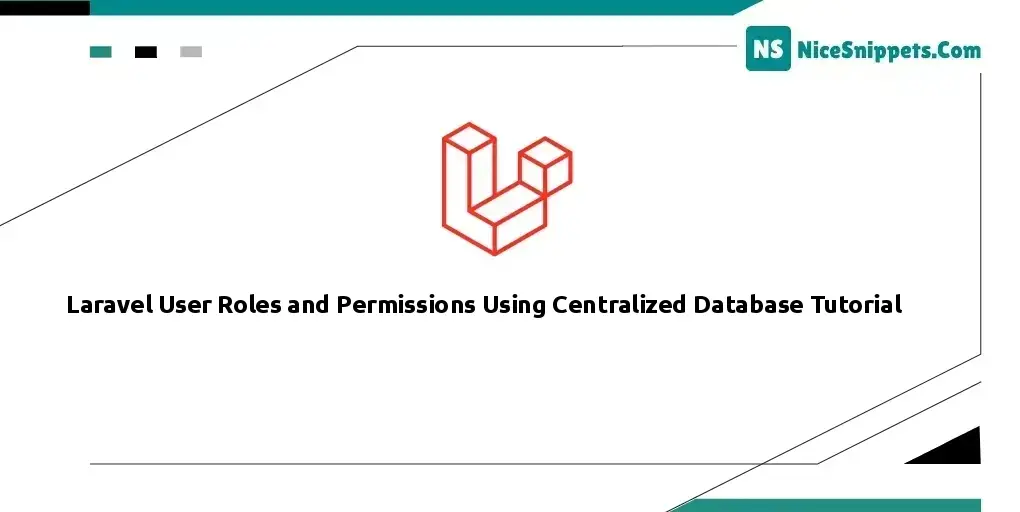26-Sep-2023
.
Admin

Hi dev,
In this tutorial, we will explore how to implement user roles and permissions using a centralized database approach in a Laravel application. This approach allows you to define and manage roles and permissions in a more structured and scalable way.
Implementing user roles and permissions using a centralized database in Laravel can greatly enhance your application's security and scalability. By structuring roles and permissions in a database, you can easily manage and modify access control as your application evolves.
Let's see the following steps:
Step 1: Set Up a New Laravel Project
If you don't have a Laravel project set up already, you can create one using the following command:
composer create-project --prefer-dist laravel/laravel user-roles-permissions
Step 2: Database Setup
Next, set up your database configuration in the .env file and run migrations to create the necessary tables:
php artisan migrate
Step 3: Create Roles and Permissions Tables
php artisan make:migration create_roles_table
php artisan make:migration create_permissions_table
Step 4: Create Models
php artisan make:model Role
php artisan make:model Permission
App/Model/CustomRole
namespace App\Model;
use Illuminate\Database\Eloquent\Model;
use Spatie\Permission\Models\Role as SpatieRole;
class CustomRole extends SpatieRole
{
protected $connection = 'mysql';
}
App/Model/CustomPermission
namespace App\Model;
use Illuminate\Database\Eloquent\Model;
use Spatie\Permission\Models\Permission as SpatiePermission;
class CustomPermission extends SpatiePermission
{
protected $connection = 'mysql';
}
Step 5: Set Environment
config/database.php
use Illuminate\Support\Str;
return [
/*
|--------------------------------------------------------------------------
| Default Database Connection Name
|--------------------------------------------------------------------------
|
| Here you may specify which of the database connections below you wish
| to use as your default connection for all database work. Of course
| you may use many connections at once using the Database library.
|
*/
'default' => env('DB_CONNECTION', 'mysql'),
/*
|--------------------------------------------------------------------------
| Database Connections
|--------------------------------------------------------------------------
|
| Here are each of the database connections setup for your application.
| Of course, examples of configuring each database platform that is
| supported by Laravel is shown below to make development simple.
|
|
| All database work in Laravel is done through the PHP PDO facilities
| so make sure you have the driver for your particular database of
| choice installed on your machine before you begin development.
|
*/
'connections' => [
'sqlite' => [
'driver' => 'sqlite',
'url' => env('DATABASE_URL'),
'database' => env('DB_DATABASE', database_path('database.sqlite')),
'prefix' => '',
'foreign_key_constraints' => env('DB_FOREIGN_KEYS', true),
],
'mysql' => [
'driver' => 'mysql',
'url' => env('DATABASE_URL'),
'host' => env('DB_HOST', '127.0.0.1'),
'port' => env('DB_PORT', '3306'),
'database' => env('DB_DATABASE', 'forge'),
'username' => env('DB_USERNAME', 'forge'),
'password' => env('DB_PASSWORD', ''),
'unix_socket' => env('DB_SOCKET', ''),
'charset' => 'utf8mb4',
'collation' => 'utf8mb4_unicode_ci',
'prefix' => '',
'prefix_indexes' => true,
'strict' => true,
'engine' => null,
'options' => extension_loaded('pdo_mysql') ? array_filter([
PDO::MYSQL_ATTR_SSL_CA => env('MYSQL_ATTR_SSL_CA'),
]) : [],
],
'mysql_central_db' => [
'driver' => 'mysql',
'url' => env('DATABASE_URL_CENTRAL_DB'),
'host' => env('DB_HOST_CENTRAL_DB', '127.0.0.1'),
'port' => env('DB_PORT_CENTRAL_DB', '3306'),
'database' => env('DB_DATABASE_CENTRAL_DB', 'forge'),
'username' => env('DB_USERNAME_CENTRAL_DB', 'forge'),
'password' => env('DB_PASSWORD_CENTRAL_DB', ''),
'unix_socket' => env('DB_SOCKET_CENTRAL_DB', ''),
'charset' => 'utf8mb4',
'collation' => 'utf8mb4_unicode_ci',
'prefix' => '',
'prefix_indexes' => true,
'strict' => false,
'engine' => null,
'options' => extension_loaded('pdo_mysql') ? array_filter([
PDO::MYSQL_ATTR_SSL_CA => env('MYSQL_ATTR_SSL_CA'),
]) : [],
],
'pgsql' => [
'driver' => 'pgsql',
'url' => env('DATABASE_URL'),
'host' => env('DB_HOST', '127.0.0.1'),
'port' => env('DB_PORT', '5432'),
'database' => env('DB_DATABASE', 'forge'),
'username' => env('DB_USERNAME', 'forge'),
'password' => env('DB_PASSWORD', ''),
'charset' => 'utf8',
'prefix' => '',
'prefix_indexes' => true,
'search_path' => 'public',
'sslmode' => 'prefer',
],
'sqlsrv' => [
'driver' => 'sqlsrv',
'url' => env('DATABASE_URL'),
'host' => env('DB_HOST', 'localhost'),
'port' => env('DB_PORT', '1433'),
'database' => env('DB_DATABASE', 'forge'),
'username' => env('DB_USERNAME', 'forge'),
'password' => env('DB_PASSWORD', ''),
'charset' => 'utf8',
'prefix' => '',
'prefix_indexes' => true,
// 'encrypt' => env('DB_ENCRYPT', 'yes'),
// 'trust_server_certificate' => env('DB_TRUST_SERVER_CERTIFICATE', 'false'),
],
],
/*
|--------------------------------------------------------------------------
| Migration Repository Table
|--------------------------------------------------------------------------
|
| This table keeps track of all the migrations that have already run for
| your application. Using this information, we can determine which of
| the migrations on disk haven't actually been run in the database.
|
*/
'migrations' => 'migrations',
/*
|--------------------------------------------------------------------------
| Redis Databases
|--------------------------------------------------------------------------
|
| Redis is an open source, fast, and advanced key-value store that also
| provides a richer body of commands than a typical key-value system
| such as APC or Memcached. Laravel makes it easy to dig right in.
|
*/
'redis' => [
'client' => env('REDIS_CLIENT', 'phpredis'),
'options' => [
'cluster' => env('REDIS_CLUSTER', 'redis'),
'prefix' => env('REDIS_PREFIX', Str::slug(env('APP_NAME', 'laravel'), '_').'_database_'),
],
'default' => [
'url' => env('REDIS_URL'),
'host' => env('REDIS_HOST', '127.0.0.1'),
'username' => env('REDIS_USERNAME'),
'password' => env('REDIS_PASSWORD'),
'port' => env('REDIS_PORT', '6379'),
'database' => env('REDIS_DB', '0'),
],
'cache' => [
'url' => env('REDIS_URL'),
'host' => env('REDIS_HOST', '127.0.0.1'),
'username' => env('REDIS_USERNAME'),
'password' => env('REDIS_PASSWORD'),
'port' => env('REDIS_PORT', '6379'),
'database' => env('REDIS_CACHE_DB', '1'),
],
],
];
Step 7: Set Env
.env
DB_CONNECTION_CENTRAL_DB=mysql
DB_HOST_CENTRAL_DB=127.0.0.1
DB_PORT_CENTRAL_DB=3306
DB_DATABASE_CENTRAL_DB=celcius_production_new_central_login
DB_USERNAME_CENTRAL_DB=root
DB_PASSWORD_CENTRAL_DB=root
Step 6: Attach Roles and Permissions to config/permission.php
'role' => App\Model\CustomRole::class,
'permission' => App\Model\CustomPermission::class,
Step 6: Used Centralized Database
$customerRevenueCharges = DB::table('loads')
->select('users.company_name as customer_name',DB::raw("SUM(loads.commission_amount) as total_amount"))
->join(env('DB_DATABASE_CENTRAL_DB').'.users',env('DB_DATABASE_CENTRAL_DB').'.users.id','loads.user_id')
->orderBy('total_amount','DESC')
->groupBy('loads.user_id')
->take(10)
->cursor();
#Laravel 10
#Laravel